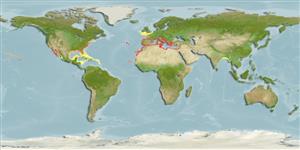Common names from other countries
Environment: milieu / climate zone / depth range / distribution range
экология
морской; мигрирует в океане (Ref. 51243); пределы глубины 0 - 700 m (Ref. 106604). Subtropical; 53°N - 13°N
Probably circumglobal in warm seas.
Size / Вес / Возраст
Maturity: Lm ? range ? - ? cm
Max length : 520 cm WD самец/пол неопределен; (Ref. 4442); наибольший вес (опубликованные данные): 1.5 t (Ref. 115943)
Краткое описание
определительные ключи | морфология | морфометрия
Larger than M. hypostoma, tail with spine and prickles (Ref. 6902).
An epipelagic species (Ref. 6808) found over continental shelves and near oceanic islands (Ref. 6679). Feeds on small pelagic fishes and crustaceans (Ref. 6679), by funnelling using their cephalic fins and then trapping or filtering the food through their specialised gill plates (Ref. 115943). Ovoviviparous (Ref. 50449). Bycatch mortalities have been reported from Mediterranean fisheries - large-scale driftnets, purse seines and trawls, bottom set nets, trammel nets, longlines and even fixed traps for tuna. It is utilized for its meat as protein source (except the head) and gill plates as ingredient in Chinese medicine (Ref. 115943)
Life cycle and mating behavior
Maturities | размножение | Spawnings | Egg(s) | Fecundities | личинки
Exhibit ovoviparity (aplacental viviparity), with embryos feeding initially on yolk, then receiving additional nourishment from the mother by indirect absorption of uterine fluid enriched with mucus, fat or protein through specialised structures (Ref. 6679, 50449).
McEachran, J.D. and B. Séret, 1990. Mobulidae. p. 73-76. In J.C. Quero, J.C. Hureau, C. Karrer, A. Post and L. Saldanha (eds.) Check-list of the fishes of the eastern tropical Atlantic (CLOFETA). JNICT, Lisbon; SEI, Paris; and UNESCO, Paris. Vol. 1. (Ref. 4442)
Статус Красного Списка МСОП (Ref. 130435)
Угроза для людей
Harmless
Использование человеком
рыболовство: коммерческий
дополнительная информация
инструменты
Специальные отчеты
Скачать в формате XML
ресурсы в Интернет
Estimates based on models
Preferred temperature (Ref.
115969): 13.1 - 23, mean 15.8 (based on 226 cells).
Phylogenetic diversity index (Ref.
82804): PD
50 = 0.5005 [Uniqueness, from 0.5 = low to 2.0 = high].
Bayesian length-weight: a=0.01000 (0.00244 - 0.04107), b=3.04 (2.81 - 3.27), in cm Total Length, based on all LWR estimates for this body shape (Ref.
93245).
Trophic level (Ref.
69278): 3.5 ±0.45 se; based on food items.
устойчивость к внешним воздействиям (Ref.
120179): низкий, минимальное время удвоения популяции 4.5-14 лет (Fec assumed to be <100).
Fishing Vulnerability (Ref.
59153): Very high vulnerability (85 of 100).
Climate Vulnerability (Ref.
125649): Moderate vulnerability (38 of 100).
